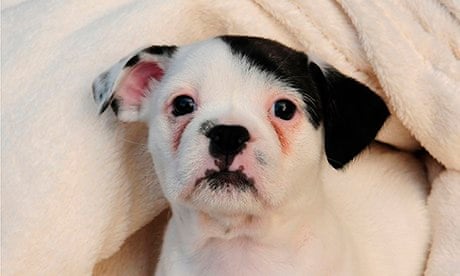I can't see it. Well I mean, I can see it because a headline told me to look for the resemblance – "Heel Hitler!" – but Patch the puppy barely looks like the Führer, if I am honest. That hasn't stopped his cute puppy face appearing all over the place next to pictures of Adolf Hitler (1889-1945), the Nazi dictator responsible for the organised murder of 6 million Jews, not to mention carrying the lion's share of blame for 72 million deaths in the second world war as a whole.
One thing to say is that Hitler might – for once – have enjoyed the joke. He did love dogs. Just before killing himself as the Russians approached his bunker in Berlin, he tenderly put down his beloved dog, Blondi. Needless to say Hitler's hapless dog looked nothing like him.
There is a psychological phenomenon behind our tendency to see images in arbitrary shapes – a modern term for this is apophenia, but it was first diagnosed by Leonardo da Vinci more than five centuries ago. "If you look at a mottled or stained wall," said Leonardo, "you may start to see landscapes, battles and strange faces." Children see faces and monsters easily in the pattern of a curtain or the shape of a cloud. Adults, more cut off from our dreams, tend to need a stronger trigger.
We might ask why Hitler is so often the "strange face" modern adults see. The Hitler puppy follows on from a house in Swansea that looked like the Führer. Why Hitler?
To answer this we need to ask why Hitler looked the way he did. Toothbrush moustaches and side partings were quite popular in the early 20th century, but Hitler managed to twist this into a globally recognised icon, as recognisable as a cartoon character. He came to power in 1933 in the age of Mickey Mouse, when cartoonists were starting to discover the power of simple graphic signs in a mass media age. Mickey's ears; Hitler's moustache.
Yet the source of Hitler's look was more specific – the most famous toothbrush moustache before his belonged to Charlie Chaplin. The hugely popular – and leftwing – silent comic had a little moustache that signified his working class identification with the common man. Hitler adopted the same demotic facial hair, to appeal to the popular culture appreciation of Chaplin. In his film The Great Dictator, the radical Chaplin got revenge by using this likeness to satirise Hitler. In another 1930s film, Duck Soup, a large pot falls on Groucho Marx, trapping his head. The other Marx brothers simply draw his trademark face – glasses, eyebrows, moustache – on the vase. This crude drawing is an effective substitute for Groucho's face, whose moustache was drawn on anyway.
What all these makers of modern culture recognised was that simple signs can substitute for the nuances of individuality to define a Mickey, a Charlie, a Groucho, a Hitler. And this brings us back to that curious human tendency to see faces and other shapes where they do not really exist. You may see a face in a puppy or a house but it is not likely to be very subtle. No one is likely to see Rembrandt's Kenwood self portrait hidden in a funny shaped hedge.
Instead, we see caricatures of faces – crude agglomerations of simple marks. It was part of Hitler's dark mastery of modern communication that he reduced his face to such a stereotype. He wrote the jokes himself, in some horrible sense, setting the script for Basil Fawlty to put his finger under his nose and for people to see a puppy as his lookalike.
In the early 20th century Picasso took apart faces in cubist portraits that are themselves psychological tricks. Can you see a face in Picasso's Portrait of Kahnweiler? The bits that are recognisable, such as wavy hair and an ear, are just as simple and cartoonish as the human face we see in a house or a puppy. We think we remember faces, but in fact we remember caricatures. The essence of perception may be cruder than we think.
Hitler was happy to aim low. A moustache, a parting, a stare. His face in a puppy? He must be laughing in hell.

